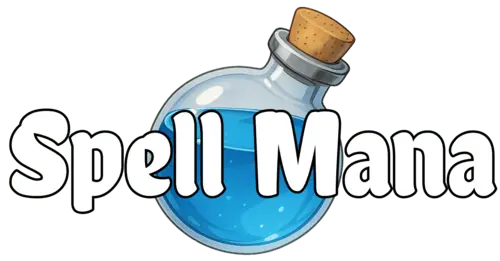Heya everyone! I wrote a One Piece TCG beginner tips almost a year ago, and since then, I’ve learned more about the game, and it’s time to expand on it! This guide will mostly be for those just starting OPTCG or who haven’t been playing for too long! However, there might be useful tips in here for seasoned players that might improve their gameplay!
Naturally, playing OPTCG and analyzing your games should help you improve drastically over time, but understanding some fundamentals before you get into the game will give you a broader perspective on what you’re doing wrong or areas you should improve on. Here, I’ll help you think of your games differently, identify those small mistakes, even though they might not seem serious, but can be game-changing, and the reason you win or lose some of your games.
Here are 8 tips to help you improve your OPTCG gameplay and push for the next level.
1- Attack before Develop
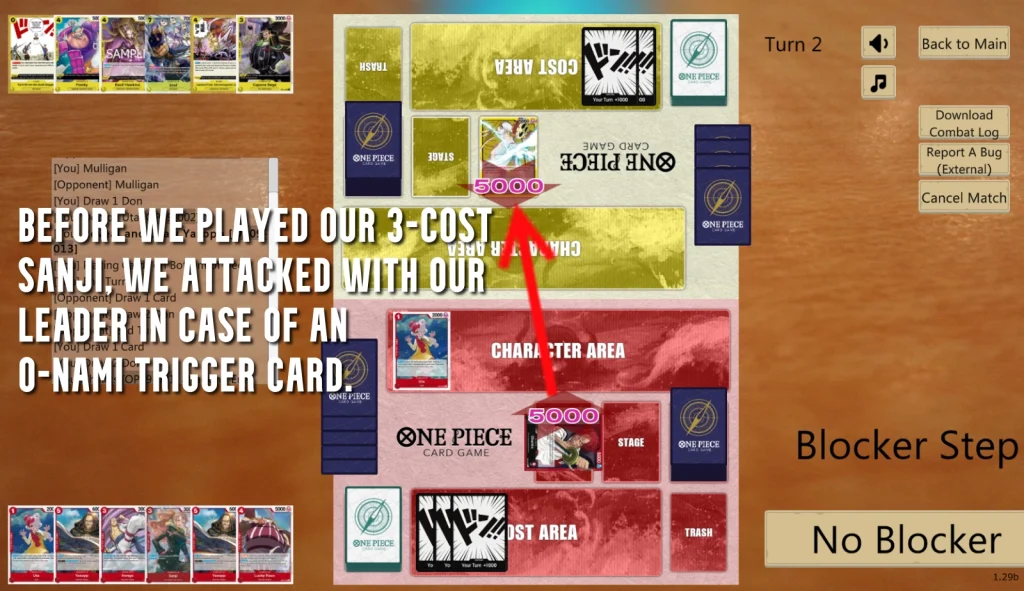
This is one of the most common mistakes made in One Piece TCG, not only by beginners, but also by seasoned players. using up their Don to develop Characters and going for an attack with their Leader or other Characters.
While there are exceptions, such as playing Mr.2 Bon Clay first to benefit from the Active Don he provides or to KO a blocker to pave the way for your attacks to go through, it’s generally better to attack before developing. Here’s why:
- Attacking with your Leader or a Character first while keeping your Don Active keeps information hidden from the opposing player. Instead of them gaining knowledge on what you’re planning to do this turn after you’ve used up all your Don, they’ll be uncertain of what your next play is. Are you going to attach more Don to your second attacker? Should I counter the first attack and take the second hit? Will they drop a Rush attacker afterward? These questions create multiple decisions, which means they might not choose the optimal one depending on what you’re planning to do.
- Trigger cards! Finger Pistol, O-Nami, or Gravity Blade Raging Tiger can remove a Character from play. So, let’s say your turn started, you played a 5-cost Character, and you decided to attack with your Leader. The top Life card for your opponent is a Trigger card that removes your 5-cost Character from the field without your opponent having to use any of their Don. You just lost a Character without forcing Don from the opposing player and put yourself behind in the game. If you’ve attacked first, taken the Life card, and then played a Character, your opponent wouldn’t be able to remove that Character.
Moreover, if you already have a 5-cost Character in play from the previous turn, you might opt to attack with it first in case of a removal Trigger card. Getting to attack with it before it potentially gets removed generates value and pressure that you want to take advantage of.
Planning your turn and Don is important and will take a while to get the hang of if you’re new to the game. It feels easier to just drop your Character and use whatever Don is left to boost your attacks, but it can be punishable in the long run. Determine how many Don cards you need to make all the development you want, and then use the remaining Don to boost your attacks.
2- How to Don Attack
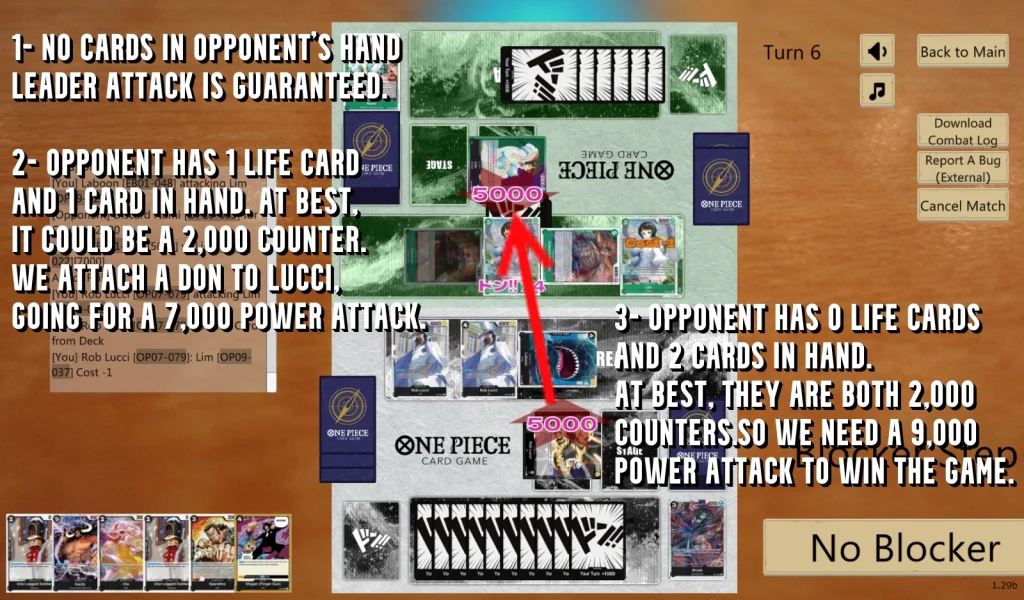
We’re attacking for multiple purposes: damaging Leader, KOing a rested Character, and forcing Counter cards.
You don’t usually want to slam all your Don cards into attacking, as you’ll still want to develop on the board to keep up with the opponent. We need to identify how many Don cards we need to play Characters/Events/Stage, and the rest can be used for Power boosts.
Prioritize removing rested Characters over attacking the Leader if their Leader is still healthy. Any Don Power boost should go to removing that Character over going for their Leader, this makes sure we don’t fall behind in the mid-game since taking Life cards over controlling the field isn’t worth it (aggro decks are often an exception, but even aggressive decks will try to KO low power rested Characters).
If our attacker is the same Power as the rested Character or Leader it’s attacking, we’re forcing out a +1,000 Counter play. However, if we attach 2 Don to our attacker, we’re attacking for 2,000 Power more than the target, we’re now forcing two Counter cards, a +2,000 and +1,000. This puts your opponent in a tough spot, forcing them to commit Counter cards and bleed out of resources or lose a Life card/Character to your attacker.
If we’re trying to win the game, start with weaker attacks before launching stronger ones. For example, if your opponent has no cards in hand and only one Life Card remaining, begin with a 5,000 Power attack, then follow with a 7,000 Power attack. This ensures that regardless of what the opponent draws, they won’t be able to Counter our attack, except if it’s a specific Event.
However, against certain Leaders like Green Bonney, you’ll want to attack with your strongest Character first due to her effect, but this is a situational case.
3- When to Counter an Attack
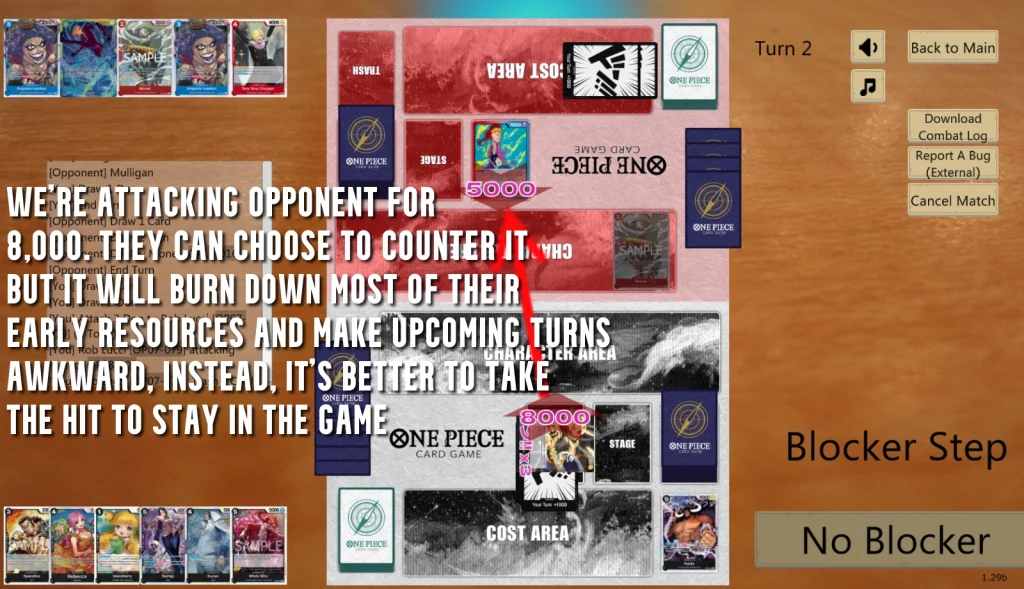
This is a valuable skill to build, and it requires understanding what your opponent’s deck is capable of. Countering correctly will save you resources and can make it difficult for opponents to close out games in the later stages. Your Life cards are also a valuable resource when in hand, allowing you to make more plays or Counter an attack later in the game.
If your opponent is attacking with an 8,000 Power attack early in the game, we’ll most likely want to take the hit instead of committing two valuable +2,000 Counters, or a +2,000 and two +1,000 Counters. Those Counter cards can be more useful later in the game to stop lower-power attacks. In the mid-game, most players can’t afford to commit too many Don cards to their attacks, as they’re also trying to develop their board. This means they’ll likely attack with 5,000 Power swings, which are easier to block using a single +1,000 Counter.
Questions to ask yourself when giving a Life card:
- Can your opponent win on the upcoming attack? Do you need to Counter this specific attack?
- Does your opponent gain something by dropping you to X Life cards? For example, if you fall to 2 Life cards, 4-cost Kid & Killer will gain a +2,000 Power boost.
- Should I bait them to use all their Don for a finisher attack? Baiting is an advanced strategy in card games, and you can give your opponent a false hope of winning the game by falling to 0 Life cards, but having the Counter power to shut down the last attack. This could prevent them from developing a blocker, but as with all baits, your opponent could play around it.
Ideally, we want to stay at 2 Life Cards, but dropping to 0 Life Cards is the danger zone. Having at least 1 Life Card will force opponents to divide their Don between two attackers, making it easier for you to counter out of one of them. Falling to 0 Life Cards means your opponent can attach all their Don on one attacker and go for the attack, if you don’t have a blocker, it’ll be almost impossible to Counter out of that attack.
4- Utilize Your Blockers
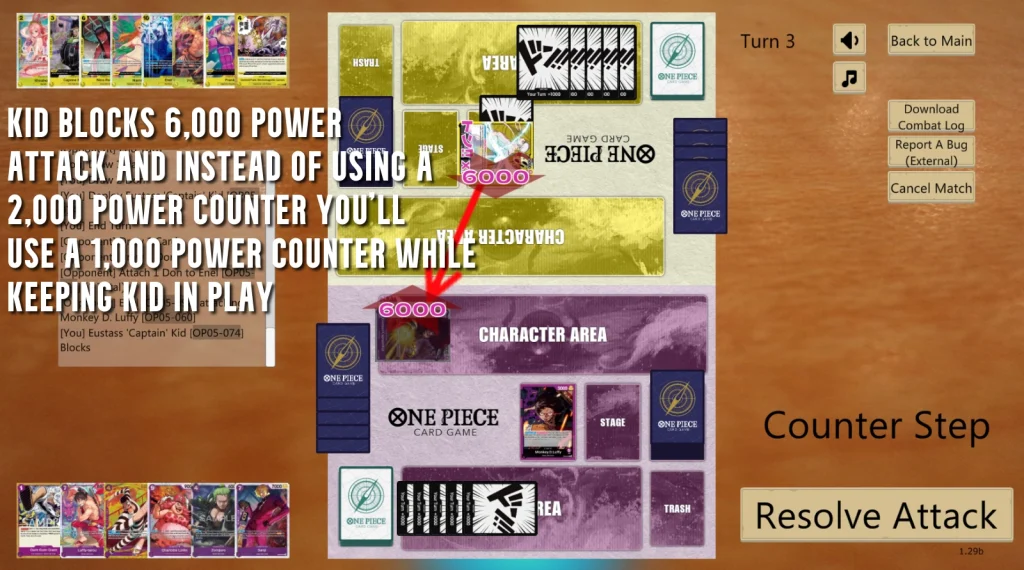
Blockers are useful for stopping an opponent’s attack, protecting your Leader or another Character, and saving your Counter cards for later.
Low-cost Blockers are easy to play and can block an attack once, but higher-power Blockers offer more value.
Since most Leaders have 5,000 Power, a Blocker with 6,000 or more Power can stop a 5,000 Power attack without needing any Counter cards and stay on the field afterward.
In some situations, you might block a stronger attack, like one with 6,000 Power, and use Counter cards to help your Blocker survive. This lets you reuse it in future turns, either to attack or block with it.
5- Hand Reading
Hand-reading is an advanced skill that takes time to master, as it requires a deep understanding of the opponent’s deck, their skill level, and the decisions they make each turn. This is one of my favorite skills to improve in card games, getting to visualize what your opponent might have in their hand and which plays they’re capable of.
Observing how your opponent plays specific turns can reveal what cards they don’t have. Keep track of the cards in their trash and what the searcher cards drew for them. This information can help you decide whether to take riskier actions or play more cautiously.
- Did your opponent skip a ramp Character they usually rely on playing?
- Did they not use a removal play to KO a valuable Character on your side of the board?
- Instead of developing, they used their Don to boost the Power of their attacks.
While hand-reading is a complex skill—even for experienced players—there are some basic techniques we can learn and use to our advantage.
One such approach is paying attention to how your opponent uses their Counter cards. For example, if you attack with a 5,000 Power Character and they respond with a +2,000 Counter instead of a +1,000, there are two likely reasons:
First, they might not have a +1,000 Counter, which means you could follow up with another 5,000 Power attack, either forcing another +2,000 Counter or getting the attack through, while saving Don for a stronger final attack.
Second, it could mean they’re intentionally holding onto their +1,000 Counter card because it’s part of their game plan. For instance, a card like Vinsmoke Reiju is often saved for its card draw effect, making players hesitant to use it just to Counter.
6- Trash is Valuable
“One man’s trash is another man’s treasure” takes on a whole new meaning in One Piece. Here, every trashed card becomes valuable intel—not just our own, but also our opponent’s.
You want to keep an eye on the opponent’s trash as it can give you valuable information on what they likely don’t have in their hand. This can help you decide to ignore playing around certain cards since the odds of them having it are pretty low.
For example, if your opponent has 6 +2,000 Counter cards in their trash, that means the odds of them having more than one +2,000 Counter card are low! This could change how we play the game, shifting our focus to more aggressive turns to try and win.
Another example is their win conditions. Black decks are notorious for trashing cards, so they might trash their win condition. Knowing that 2 or more copies of a certain Character are in the trash means they’re less likely to have one in their hand. They could still have a copy in their hand, but the odds are less.
In most cases, you won’t be 100% correct when hand reading, but that’s how it works, using stats to your advantage, and throughout many games, you’ll be gaining a slight advantage over the opposing players.
7- Aggro or Control
Deciding between attacking a Leader or a Character depends on your deck, the matchup, and the game’s current state.
Opponents are typically more inclined to defend a rested Character than their third or fourth Life Card. Characters with 5,000 Power or more are a threat, capable of KOing a rested Character or forcing the opponent to spend Counter resources.
For most decks, controlling the board is a priority over aggroing down the opponent’s Leader. We want to use whatever Don we have left after developing to ensure our attack goes through on their rested Character.
Things change if we’re winning the board and the opponent is low on Life Cards. Instead of targeting their rested Character, we can shift our plan to target the opponent’s Leader, forcing them to play their Counter cards and eventually drop them to 0 Life Cards. Having a player at 0 Life Cards means they’re vulnerable to one massive swing with our Leader that could close out the game if they don’t have a blocker.
The decision to shift to full aggression or board control comes down to matchup knowledge and experience. Your hand and the opponent’s board state play a role as well, if we feel we’re not at threat of losing the game on the upcoming turn, going full aggro could make sense to set the stage to win the game.
8- The Value of Life Cards
Life Cards are a core part of the One Piece card game, not just to protect your Leader from attacks, but also for their value in your hand and their Trigger effects. Taking early hits means we get to either activate a valuable Trigger effect or add more cards to our hand. Having more cards in the mid-game enables us to make more plays, especially if we’re certain cards for our strategy and they happen to be in our Life Area.
9- Play to Win, not to Lose
In some games, you’ll find yourself in a tough spot, struggling to keep up with the opponent as the game progresses. This is where you must decide whether to aim for a win or drag out a slow loss. Obviously, winning is the preferred choice.
Instead of focusing on controlling the board or matching the opponent’s plays, consider using your resources to launch a full, aggressive attack on their Leader, especially if they are down to 1 or 2 Life Cards. This is a last-resort strategy when you believe you’ll likely lose on your next turn.
Sometimes, your opponent might not have enough Counter cards to protect their Leader and could lose to your all-out attack.
10- Familiarize Yourself with Card Colors and Their Playstyles
Red: Aggressive, focusing on quick attacks.
Green: Emphasizes resting your Characters.
Blue: Controls the board by returning cards to the hand.
Black: Focuses on KO’ing opponent’s characters/cost reduction.
Purple: Centers around DON!! acceleration. Ramping and playing big bodies.
Yellow: Utilizes life manipulation and trigger effects.
